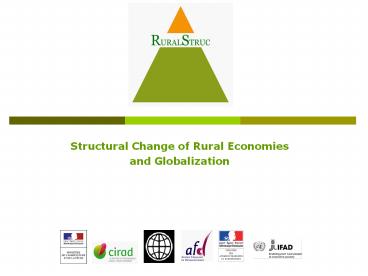Structural Change of Rural Economies - PowerPoint PPT Presentation
1 / 25
Title:
Structural Change of Rural Economies
Description:
Main hypotheses. Rural households do adapt through diversified activity and income strategies which are reshaping rural economies. Global agro-food markets restructuring – PowerPoint PPT presentation
Number of Views:98
Avg rating:3.0/5.0
Title: Structural Change of Rural Economies
1
- Structural Change of Rural Economies
- and Globalization
2
Main hypotheses
Rural households do adapt through diversified
activity and income strategies which are
reshaping rural economies
Global agro-food markets restructuring
reinforcerural economies differentiation
Marginalization trends resulting from these
processes of structural change could lead to
risks of transitional dead-ends
3
General Design
- Not an assessment / forecast / foresight only
an update!! - A 3-year comparative program implemented in 7
countries - Mexico
- Kenya, Madagascar, Mali, Senegal
- Morocco, Nicaragua
- Two main phases
- Phase 1 general country overviews
- Phase 2 Regional case studies value chains
reviews rural household surveys - 26 regions, near 9,000 surveyed HH
- A focus on rural incomes
- National teams Institutional Operational
partners - Contribution to the local policy debate
4
Agriculture for Development
5
The WDR08 and the three worlds of agriculture
6
The Evolutionary Path
7
The policy diamond and the 3 exit pathways
8
Exple Agriculture-based Countries
9
What do these 3 exit pathways mean?
- Between the Ag. Specialization, rural
diversification, and migration options what are
the realistic / acceptable / viable /sustainable
ones? What are the right shares? - 10/20/70 or 40/40/20?
- gt What is the room for maneuver of the policy
makers?
10
What do we learn from the past?
- The structural transformation of Western Europe
and its offshots is embedded in Western
imperialism Bairoch, Braudel, Pomeranz, Chang,
etc. - The capture of America and domination of Western
Europe during 5 centuries helped its structural
transformation specialization and migrations - The transformation of the so-called emerging
countries occurred during the nation state led
period between the 2 WW gt the 2nd
globalization
11
Where are the Ag. Based countries, what do they
face, what can they do?
- The Ag. based countries mainly SSA face huge
challenges - An incipient economic transition
12
Structural Change East Asia vs SSA
Manufacturing GDP
Agriculture GDP
13
Where are the Ag. Based countries, what do they
face, what can they do?
- The Ag. based countries mainly SSA face huge
challenges - An incipient economic transition
- An incomplete demographic transition
14
Yearly Cohorts
15
(No Transcript)
16
Where are the Ag. Based countries, what do they
face?
- The Ag. based countries mainly SSA face huge
challenges - An incipient economic transition
- An incomplete demographic transition
- The constraints of climate change
- In the context of globalization
- High international competition
- One size political framework
- These challenges are insufficiently considered
- gtit represents a historically unique
configuration
17
What can they do?
- Back to the 3 exit pathways
- And back to rural realities of the Ag.based
countries - Here some RuralStruc results can help
- The overall conclusions
- Huge heterogeneity
- But sobering results
18
Annual Income per Capita in the Surveyed Regions
(PPP 2007)
19
PPP 1 Income Classes
20
Quintiles of Households by Region (PPP 2007)
21
(No Transcript)
22
Structure of Households Global Income
23
(No Transcript)
24
What does it mean?
- If we want to eradicate hunger
- We to need to deal with the many family
farms /smallholders because exits are limited - The are no market solutions only
- Under 2 a day no investment capacity
- Need of public support public goods - of course
- but not only
25
What does it mean?
- A need to focus first on food crops
- Food insecurity remains and rural households are
risk adverse - Food crops are the most inclusive
- Then upgrade the added value ag.
diversification transformation - And keep in mind that rural diversification
starts with the growing rural demand - gt Ag. Income remains a key































